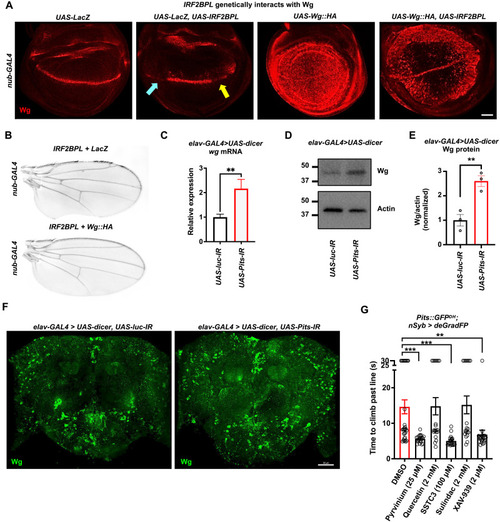Fig. 3
- ID
- ZDB-FIG-230205-22
- Publication
- Marcogliese et al., 2022 - Loss of IRF2BPL impairs neuronal maintenance through excess Wnt signaling
- Other Figures
- All Figure Page
- Back to All Figure Page
|
Wingless genetically interacts with IRF2BPL, and neuronal reduction of Pits in neurons leads to increased wg transcription.
(A and B) Coexpression of UAS-IRF2BPL with UAS-Wg::HA, but not UAS-LacZ, in the wing disc using nub-GAL4 at 18°C restores Wg expression along the DV boundary (A) and the adult wing margin morphology (B). Scale bar, 40 μm. (C to F) Neuronal reduction of Pits via RNAi using elav-GAL4, UAS-dicer results in increased wg transcript (C) by qPCR and Wg protein (D) in 20 d.p.e. fly heads, as quantified in (E) and by immunohistochemistry (F) in the adult brain of 20-day-old flies stained for Wg. Results are means ± SEM (**P < 0.01). Statistical analyses were determined by two-tailed Student’s t test. Scale bar, 50 μm. (G) Climbing assessment of Pits::GFPDH; nSyb-GAL4, UAS-deGradFP flies at 25 d.p.e. after adult-specific reduction of Pits::GFP and treatment with DMSO or indicated Wnt inhibitors. Time (seconds) required for flies of the indicated genotypes to climb past 7 cm (n > 20 per genotype). Statistical analyses were determined by ANOVA followed by Tukey post hoc. Results are means ± SEM (**P < 0.01 and ***P < 0.001). |

